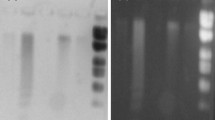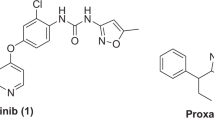Abstract
In this study, two series of simplified isoquinolines deriving from lophocladine B were synthesized and evaluated for their antitumor activity. Suzuki-Miyaura and Sharpelss-Fokin reactions were employed to synthesize 26 compounds. Two compounds (25 and 27) showed to be cytotoxic with IC50 values of 10 µM on hepatic cancer cells and 13 µM on cervical cancer cells, respectively. Further studies on their mechanism of action showed that compound 27 mediated cytotoxicity through apoptosis induction.







Similar content being viewed by others
References
Arif JM, Al-Hazzani AA, Kunhi M, Al-Khodairy F (2004) Novel marinePlease provide volume number in the reference Arif et al. (2004). compounds: anticancer or genotoxic? J Biomed Biotechnol (2): 93–98
Boopathy NS, Kathiresan K (2010) Anticancer drugs from marine flora: an overview. J Oncol 2010:1–18
Disadee W, Ploypraditha P, Aree T, Chaichit N, Ruchirawata S (2011) A novel approach for the synthesis of lophocladines A, B and C1 analogues. Tetrahedron Lett 52:6142–6144
Dutta UW, Lupton DW, Maiti D (2016) Aryl nitriles from alkynes using tert-butyl nitrite: metal-free approach to C≡C bond cleavage. Org Letter 18(4):860–863
Faulkner DJ (2002) Bioactive marine natural products. Nat Prod Rep 19:1–48
Fuller RW, Cardellina II JH, Kato Y, Brinen LS, Clardy J, Snader KM, Boyd MR (1992) A pentahalogenated monoterpene from the red alga Portieria hornemannii produces a novel cytotoxicity profile against a diverse panel of human tumor cell lines. J Med Chem 35(16):3007–3011
Gamal AAE (2010) Biological importance of marine algae. Saudi Pharm J 18(1):1–25
Gunasekera SP, Gunasekera M, Longley RE, Schulte GK (1990) Discodermolide: a new bioactive polyhydroxylated lactone from the marine sponge Discodermia dissoluta. J Org Chem 55(16):4912–4915
Güven KS, Percot A, Sezik E (2010) Alkaloids in marine algae. Mar Drugs 8(2):269–284
Haefner B (2003) Drugs from the deep: marine natural products as drug candidates. Drug Discov Today 8(12):536–544
Itharat A, Plubrukarn A, Kongsaeree P, Bui T, Keawpradub N, Houghton PJ (2003) Dioscorealides and dioscoreanone, novel cytotoxic naphthofuranoxepins, and 1,4-phenanthraquinone from Dioscorea membranacea Pierre. Org Lett 5(16):2879–2882
Jordan MA, Wilson L (2004) Microtubules as a target for anticancer drugs. Nat Rev Cancer 4(4):253–265
Kuppens ELM (2006) Current state of the art of new tubulin inhibitors in the clinic. Curr Clin Pharmacol 1(1):57–70
Lei J, Zhou J (2002) A marine natural product database. J Chem Inf Comput Sci 42(3):742–748
Loo GV, Saelens X, Gurp MV, MacFarlane M, Martin SJ, Vandenabeele P (2002) The role of mitochondrial factors in apoptosis: a Russian roulette with more than one bullet. Cell Death Differ 9(10):1031–1042
Lotter M, Schilling J, Reimann E, Bracher F (2006) First total synthesis of the 2,7-naphthyridine alkaloids lophocladine a and B. Arch Pharm (Weinheim) 339(12):677–679
Luesch H, Moore RE, Paul VJ, Mooberry SL, Corbett TH (2001) Isolation of dolastatin 10 from the marine cyanobacterium Symploca species VP642 and total stereochemistry and biological evaluation of its analogue symplostatin 1. J Nat Prod 64(7):907–910
Mohareb RM, Abdallah AEM, Abdelaziz MA (2014) New approaches for the synthesis of pyrazole, thiophene, thieno [2,3-b]pyridine, and thiazole derivatives together with their anti-tumor evaluations. Med Chem Res 23(2):564–579
Pettit GR, Ode RH, Herald CL, Von Dreele RB, Michel C (1976) Antineoplastic agents. 46. The isolation and structure of dolatriol. J Am Chem Soc 98(15):4677–4678
Punganuru SR, Madala HR, Srivenugopal KS (2016) Colchicine-based hybrid anticancer drugs to combat tumor heterogeneity. Med Chem (Los Angeles) 6:165–173
Schwartsmann G, Brondani da Rocha A, Berlinck RG, Jimeno J (2001) Marine organisms as a source of new anticancer agents. Lancet Oncol 2(4):221–225
Utsintong M, Massarotti A, Caldarelli A, Theeramunkong S (2013) Parallel synthesis of “click” chalcones as antitubulin agents. Med Chem 9(4):510–516
Wang Y, Zhang H, Gigant B, Yu Y, Wu Y, Chen X, Lai Q, Yang Z, Chen Q, Yang J (2016) Structures of a diverse set of colchicine binding site inhibitors in complex with tubulin provide a rationale for drug discovery. Fed Eur Biochem Soc J 283:102–111
Acknowledgments
This research was financially supported from the Office of the High Education Commission and Mahidol University under the National Research Universities and the Commission on Higher Education (grant number CHE-RG-2551-53). We would like to thank Dr. Supachoke Mangmool (Department of Pharmacology) and Dr. Jiraphun Jittikoon (Department of Biochemistry) from Mahidol University for their biological suggestion, facility support, and assistance.
Disclaimer
The authors are responsible for the content of the paper.
Author information
Authors and Affiliations
Corresponding author
Ethics declarations
Conflict of interest
The authors declare that they have no conflict of interest.
Electronic supplementary material
Rights and permissions
About this article
Cite this article
Theeramunkong, S., Vajragupta, O. & Mudjupa, C. Synthesis and biological evaluation of simplified analogs of lophocladine B as potential antitumor agents. Med Chem Res 25, 2959–2964 (2016). https://doi.org/10.1007/s00044-016-1717-5
Received:
Accepted:
Published:
Issue Date:
DOI: https://doi.org/10.1007/s00044-016-1717-5




